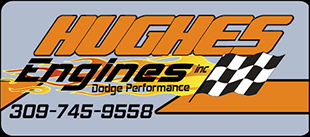STAINLESS STEEL KIT WITH STUDS & GUIDEPLATES FOR MAGNUM ENGINES. ROC
P/N 1550 & P/N 1560
|
ITEM
|
QUANTITY
|
|
Rocker Arms
|
16 each
|
|
Rocker Arm Polylocks
|
16 each
|
|
Guide Plates
|
8 each (1550 only)
|
|
Studs
|
16 each (1550 only)
|
Thank you for purchasing our stud mount rocker arm system. They are engineered to maximize valve train efficiency for Mopar performance aftermarket and racing cylinder heads.
Stud Rocker Arm System Preparation:
Please read these instructions carefully before beginning your installation. If there are any questions or problems during installation, please do not hesitate to contact Hughes Engines, Inc. at (309) 745-9558.
- Confirm that all parts are included by comparing to the parts list above.
- Make certain that you have all the tools necessary to complete the project.
- Assembly lube and/or lubricating oil should be readily available for installation.
Stud Rocker Arm System Installation:
Step 1: After removing the rockers and other components from the package, thoroughly wash each piece with solvent and then blow dry.
Step 2: Prior to installation, submerge the rockers in engine oil for approximately 30 minutes to insure the roller tip and fulcrum are properly lubricated.
Step 3: Install the pushrods. Make sure the pushrod is properly seated in the lifter. Fill each pushrod with engine oil, one at a time, as you install each rocker arm. This is to insure immediate lubrication when the engine is started and help prevent any galling. Also, apply a little high pressure grease lube to each pushrod tip and all rocker arm pushrod seats.
Step 4: If your kit uses guide plates, install them first and then install the rocker stud. Place rocker arms on the rocker arm studs, making sure the flat side of the trunnion is facing up.
NOTE: The guide plate’s position will determine the roller’s position on the valve tip. Check this position and make sure the roller is centered, front-to-rear, on the valve tip before tightening the studs.
Step 5: Check for clearances. Make sure the rocker does not touch the lower portion of the rocker arm stud, guide plate, or the stud boss. Also, check the clearance between the spring and the body of the rocker. This should be a minimum of 0.040”. The smallest amount of clearance occurs when the valve is closed and the lifter is at base circle. Always hand turn the crank to verify there is proper clearance of the rocker arm throughout the entire travel of the valve.
Step 6: Hand turn crankshaft in the running rotation until the exhaust pushrods begin to move upwards. This will bring the intake lifter to base circle and allow the intake valve for that cylinder to be adjusted.
Step 7: For Intake Valves: Hydraulic Lifter Cams: Tighten the adjusting nut by hand until all slack between the rocker and pushrod is gone. Do this by turning the pushrod with your fingers as you tighten the polylock. Continue this until you feel a slight resistance in the spin of the pushrod. This process puts you at zero lash. At this point, turn the polylock another 2 turns, when using O.E.M. lifters. Once adjusted hold the hex nut of the polylock and tighten the set screw.
Step 8: Exhaust Valves: Hand turn the crankshaft until the intake pushrod has reached maximum lift and is between one half and two thirds of the way back down. The exhaust lifter is now at base circle enabling you to properly adjust the exhaust valve for that cylinder. Repeat Step 7 for the remaining exhaust valves. When this is completed, all the valves should be at proper pre-load position.
Step 9: Before installing the valve covers for the final time, check for proper clearance between rockers and valve covers. Then, pour a pint of engine oil over the rocker arms to insure proper lubrication. Finally, replace the valve covers on the heads.
It is the responsibility of the installer to ensure that all of the components are correct before installation. Hughes Engines assumes no liability for any errors relative to tolerances, component selection or installation.




